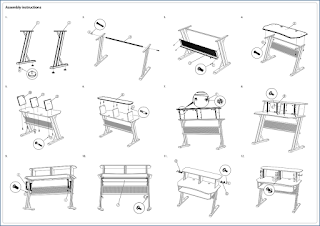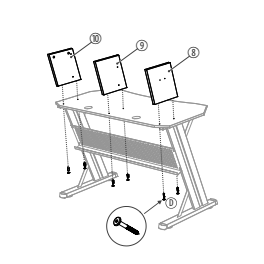My Home "Studio" Build: Part 2 - The Desk
In my blog post "My Home "Studio" Build: Part 1 - The Room" I promised to follow that up with other posts. I suppose the "Part 1" bit was a bit of a give away. Well, back in March I did publish the second video in the series - I just forgot to do the accompanying blog post! Sorry. So here it is. And just in time before I publish part 3 in a week or so's time.
Once again, if you'd rather watch the video, fill your boots. Here it is:
The desk in question is my Thomann Millennium SD-120 Studio Desk. The desk arrived as a flat pack and the video is an in depth review of how it all went together and what I think of the finished product.
In this post I'm going to limit myself to pointing out a few things to watch out for when building the desk and giving my overall impressions. If you want all the gory detail of the build please watch the video.
One more thing before we start. I bought this desk with my own money. This is not a sponsored review, so you're getting my frank opinion.
DIY and me
DIY and me don't mix well and I'm more than a little cack-handed. This desk is the most complicated build I've ever attempted. So I took things very slowly - it took me three hours, including filming. Some people claim it takes about an hour, which I can see might be possible.
Why this desk?
My main requirements were:
- The desk must fit in my tiny room - see the previous post to find out just how tiny the room is.
- I wanted a keyboard drawer large enough for my 49 key MIDI keyboard.
Now, most of the desks I saw that were within my limited budget were either too large, more expensive, didn't have keyboard drawers or had drawers that were too small.
The Thomann desk was one of the few that met my criteria and was very competitively priced. It also had some pretty good reviews. Here's a pic of the completed desk in situ:
As you can see, apart from the keyboard drawer, the desk has a shelf above two 19 inch 5u racks. Neither are something I required, but the desk still comes out tops on my other requirements, so I had no objection to having the racks or the shelf.
Ordering & delivery
I ordered the desk from Thomann in Germany via their website. Delivery took just under two weeks from Germany to Wales.
Side note: As I'm in the UK I deliberately bought the desk before the country left the EU to avoid any problems with import bureaucracy or with customs duty. Dunno what the score is now!
The whole process could have been better.
I failed to provide a piece of information (my fault) and Thomann got in touch to ask for it. I provided it straight away. Then they went quiet. No confirmation the information had been received and their website still showed that the order was on hold, pending the requested information, for a few days.
Just as I was about to contact them, the website finally showed the order had been released and I got tracking info. Tracking info that didn't work until the desk finally arrived in the UK! Once the package was handed over to UPS they gave me a delivery date and then delivered the day before. Luckily we were in!
Result: not impressed with either Thomann or UPS. Anyway, it was here.
First impressions
The desk was pretty well packed and arrived undamaged and complete, except that there was a minor ding on the main desktop, but not in a place where it would be easily noticed. If I'd been buying this from a showroom I'd have rejected it, but it certainly wasn't bad enough to go through the hassle of returning the desk and getting a replacement.
All the parts have stickers with a number that relates to the instruction sheet. Sadly the instructions are absent any actual text - using only pictograms. They were mostly easy to follow, except in a few places where I felt they were confusing. Now, I don't think pictorially and prefer to read actual instructions, so my experience may have been worse than it will be for others.
All the fittings were separated from each other and labelled and were therefore very easy to identify. All in all it seemed to be a well thought out package.
Tools
A single Allen Key was provided which, in theory, could be used for most of the construction. However a cross-head (Phillips) screwdriver is also needed for some fittings.
I also ended up using a powered screwdriver with a hexagonal bit, along with an extension shaft. I also resorted to using a flexible shaft in a couple of places.
The extension shaft was needed because some of the screws are in hard to reach places. The power tool also helped a lot because some screws were hard to turn. Having arthritis in my wrists didn't help!
The build
I did the whole build single handed, which was fine for most of it, but a helper would have, er, helped.
In the following description assume that if I don't mention a step, everything was fine. I'm just going to focus on where I encountered some problems or where you need to be careful.
Step 3
When fitting the main cross piece component between the legs, take care to get it the right way round. I didn't at first!
This part gives the desk a lot of its rigidity so make sure the screws are really tightened up. I didn't tighten them enough with the result that my desk started rocking from side to side after a couple of weeks. Retightening fixed it, and the problem has never recurred.
Step 4
The desktop screws were quite hard to reach. I used the power screwdriver and extension bar here.
This is another component that gives the desk its rigidity, so tighten those screws really well.
Step 5
I struggled to get the correct orientation for the three black risers that hold up the shelf. Just get the pre-drilled holes for the rack mount bars towards the front, get the large holes on the end risers to face inwards and don't worry about which direction the large hole in the centre riser faces - mine didn't match the instructions, which led to much head scratching and not a little cursing.
Some of the fitting screws are a bit inconveniently located and I need the extension shaft again.
Step 9
Fitting the drawer slides is a three handed job! To avoid damaging the desk by laying it on its back I fitted these from underneath, meaning that gravity wasn't exactly helping out! Someone to hold the slides in place would really help here.
Do what I didn't and tape the drawer slides closed before fitting to stop them sliding around.
Step 11
The headphone hooks look easy to fit, but the screw holes are in line with the ends of the hooks. making them a bit fiddly.
I found the flexible shaft that I mentioned earlier very useful here.
Step 12
This is the stage where you're supposed to fit the screws that are designed to hold rack gear in place. I skipped this stage because I have no such gear. Consequently I don't know how well the rack is aligned.
All done
I was agreeably surprised how well the desk went together. OK there were some frustrating moments, but I ended up with a structurally sound and un-damaged desk. Which for me is amazing!
What's the desk like to use
Overall, I'm very pleased with it.
Once I'd got the screws in the stiffening panel sufficiently tight, the desk is very stable with all my gear installed and heavy speakers up on the shelf. The keyboard drawer runs smoothly and is a decent size.
Even though I wasn't bothered about getting a desk with a shelf, it is pretty useful for holding other bits of gear. However, it's a bit high for speakers. I've got mine tilted downwards towards my listening position. I normally sit quite low to get my legs under the keyboard shelf, but find I have to increase the height of the chair to get my ears closer to a decent listening position. I wouldn't fancy putting a video monitor up there either - or rather I don't fancy the resulting neck strain!
But, the shelf needs to be high to accommodate the 5u rack, so it's a bit of a compromise.
Side note: After using the desk for some time I am considering removing the shelf and dropping the speakers down onto the desk top, possibly on some small stands. I haven't finally decided, but if I do it I'll do another post or video.
Summing up
As should be clear, my overall impression is positive. The downsides for me were the ordering and delivery process (which may not be everyone's experience), and the instructions for their lack of text.
Let's do some scoring (marks out of 10):
- Ordering and delivery: 6
- Packaging and condition: 9
- Instructions: 7
- Build: 9 (I'm making allowances for my atrocious DIY skills here!)
- Value for money: 10
- Overall impression: 9
So, would I recommend it? Well if you have similar needs to me, then yes, absolutely.
Coming up
Next up is a description of my audio and computing equipment. When? I'm currently putting the finishing touches to the video and plan to publish it in early July. Promise? Maybe!
Following that will be at least one post about acoustic treatment. Trouble is I haven't bought any yet, so it'll be a while before I tackle that subject.











Hi Alo,
ReplyDeletethanks for your very useful studio series - I've been looking at that Thomann desk, and that is how I found you, and then watched all three episodes. Irish sea in Wales, so I guess you're somewhere in West Wales? I have friends there...
Nice to "meet" you like this!
And greetings from Germany,
Wolfgang